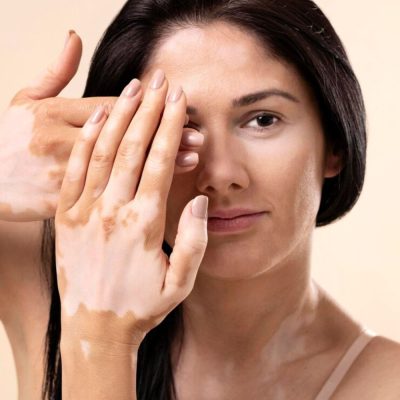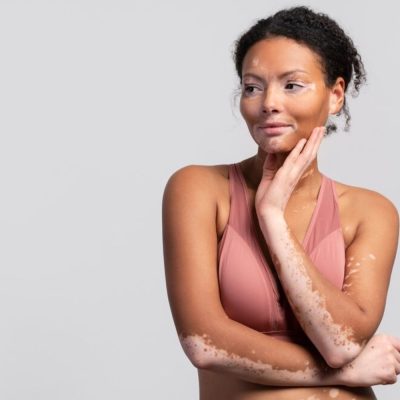Hypopigmentation
Hypopigmentation is characterized by lighter patches or spots on the skin due to a reduction in melanin, the pigment responsible for skin colour. Unlike hyperpigmentation, where there is an excess of melanin, hypopigmentation involves a decrease or absence of pigment in certain areas. At SkinAccess Clinics, we offer specialized care for hypopigmentation, intending to restore an even skin tone and improve cosmetic outcomes

What is Hypopigmentation?
Hypopigmentation occurs when the skin loses its normal pigmentation. This results in lighter patches compared to the surrounding skin. These patches can appear anywhere on the body and can vary in size and shape. Hypopigmentation can be congenital (present from birth) or appear later in life. While hypopigmentation is not harmful, it can be a cosmetic concern and may impact a person’s self-esteem.
Hypopigmentation can present in a few different forms:
Vitiligo
A chronic condition where an overactive immune system attacks pigment-producing cells, leading to irregular white patches on the skin.
Albinism
A genetic condition where individuals are born (congenital) with little to no melanin production. This results in lighter skin, hair and eyes.
Post-Inflammatory Hypopigmentation (PIH)
A loss of pigment is caused following inflammation or injury to the skin.
Symptoms of Hypopigmentation
The primary symptom of hypopigmentation is the appearance of lighter patches or spots on the skin. Their colour can vary from pale beige to white and they usually appear lighter than the surrounding skin. Other common symptoms include
Irregularly Shaped Patches
Affected areas may have well-defined or irregular edges.
Size Variation
Patches can be small or cover larger areas of the body.
No Associated Symptoms:
Unless it is associated with an underlying condition, the affected areas are typically not itchy or painful.
Causes of Hypopigmentation
Hypopigmentation can result from various causes, depending on the type of condition
The exact cause is unknown, but is believed to involve an overactive immune system which attacks melanocytes (pigment-producing cells).
Caused by genetic mutations affecting the production of melanin
It is caused due to the disruption of normal melanin production in the affected areas. This occurs following skin inflammation or injury like acne, eczema or burns.

Diagnosis of Hypopigmentation
Diagnosing hypopigmentation involves a comprehensive evaluation by a dermatologist. This includes
Physical Examination
The appearance, location and distribution of the affected areas are assessed.
Medical History
The patient’s history is reviewed to gain information about any previous skin conditions, injuries or family history of similar conditions.
Ultraviolet (UV) Light Examination
UV light may be used to assess the extent of pigment loss and differentiate between various types of hypopigmentation.
Skin Biopsy
At times, a skin biopsy may be required to examine the skin’s structure and confirm the diagnosis.
Management and Treatment of Hypopigmentation
The underlying cause and extent of pigment loss determines the management and treatment of hypopigmentation. At SkinAccess Clinics, we offer a range of personalized treatment plans designed to improve the appearance of the affected areas.
➥ Topical Treatments:
- Steroid Creams: Certain creams may be prescribed, that help reduce inflammation and stimulate pigment production. This is particularly used for vitiligo cases.
- Calcineurin Inhibitors: Creams and ointments may be prescribed for use on sensitive areas and are effective in treating vitiligo.
➥ Light Therapy:
- Narrowband UVB Therapy: Particularly used to treat vitiligo, it involves exposing the skin to ultraviolet B (UVB) light. This stimulates melanocyte activity, improving pigmentation.
➥ Pigmentation Restorative Procedures:
- Micropigmentation: This helps to camouflage affected areas by introducing pigment into the skin. It is also called ‘tattooing’.
- Skin Grafting: For more extensive cases of vitiligo, surgical grafting may be considered an option to restore pigment.
➥ Supportive Measures:
- Sun Protection: Regular use of sunscreen is a must to protect affected areas from sunburn and further pigmentation loss.
- Cosmetic Cover-Ups: The use of makeup or skin-coloured products can help to blend the affected area with the surrounding skin.
➥ Management of Underlying Issues: Properly treating underlying conditions like acne or eczema that could lead to post-inflammatory hypopigmentation (PIH), can help prevent further pigment loss.
Conclusion
Hypopigmentation can impact an individual’s mindset and quality of life. However, with the right diagnosis and treatment, it is possible to improve skin appearance and restore a person’s confidence. At SkinAccess Clinics, we are committed to providing you with personalized care and treatment plans that best suit you and your condition. If you are concerned about hypopigmentation or are seeking treatment options, schedule a consultation with us today to explore the best solutions for your skin health!
© 2025 SkinAccess Clinics, All Rights Reserved. Made by Spoiledideas.
